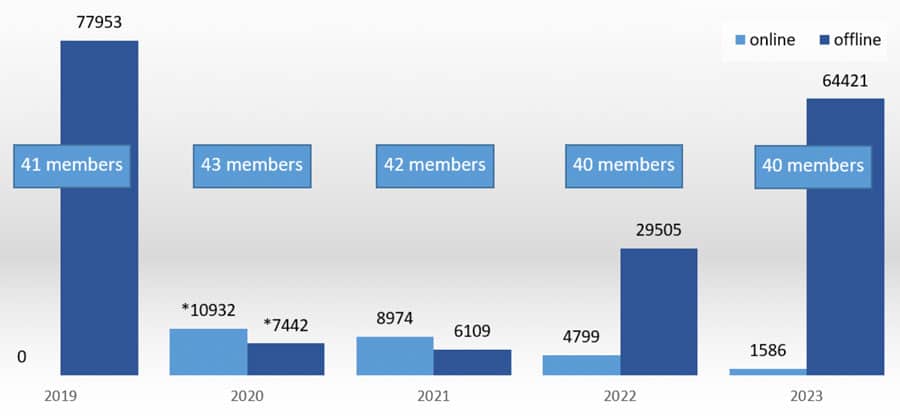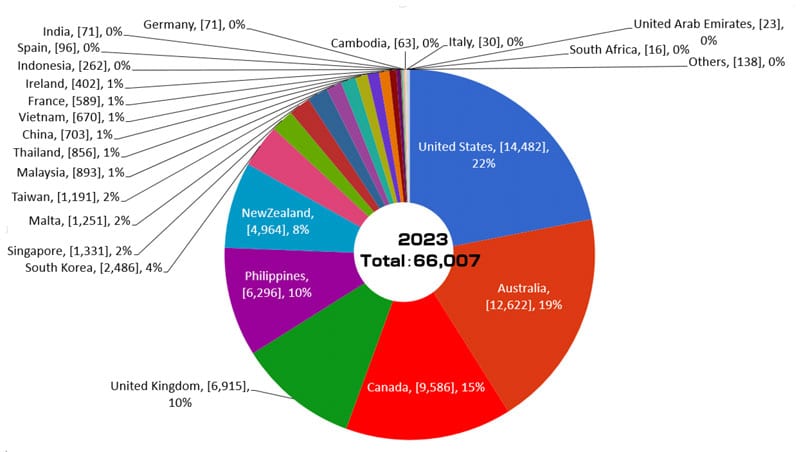Survey of Japanese agents indicates significant recovery in outbound student numbers for 2023
- Japanese agencies report that outbound numbers were up by more than 200% in 2023 and have now recovered to 83% of pre-COVID levels
- However, destination choices continue to shift for Japanese students and more are choosing to study within Asia
- A national association of agencies and other important stakeholders (JAOS) projects continued strong growth in the coming decade, based in part on a government plan to more than double the number of outbound students by 2033
The annual survey of The Japan Association of Overseas Studies (JAOS) has just been released. This year's survey was conducted in April 2024 and it again provides a baseline indicator of outbound mobility from Japan based on responses from a sample of 40 JAOS member-agencies.
The survey finds that study abroad numbers recovered to 83% of pre-pandemic volumes in 2023, driven by a 218% year-over-year increase from 2022. Overall, foreign study by Japanese students is now overwhelmingly undertaken in person with the number of online students falling dramatically over the last three years. The report notes that, "While offline study abroad is on the rise, the number of Japanese students taking online study abroad courses has decreased significantly from 4,799 in the previous year to 1,568, down from approximately 10,000 in 2020 during the COVID-19 pandemic."

The United States, Australia, and Canada remain the top three choices for Japanese students, but the survey indicates that Asian destinations are quickly gaining in popularity. The number of Japanese students studying within Asia reached an all-time high in 2023. And while Asia was the third most-popular destination region last year, after North America and Oceania, Japanese enrolments across Asia now surpass pre-COVID levels (at 112% of 2019 levels in 2023).
Along with the Philippines, other quickly growing destinations for Japanese students within Asia include South Korea, Malaysia, and Taiwan. JAOS adds that, "[Korea] has rapidly improved its relations with Japan since last year and has gained global attention through K POP, K dramas, and movies. Additionally, Malaysia and Taiwan, which have been known as new destinations for Japanese students to study abroad for degree programmes due to the depreciation of the yen and inflation in countries like the United States and Australia, have also increased in popularity."

JAOS respondents reported that three in four of Japanese students (74%) go abroad for language study programmes of less than three months. Another 12% also go for language studies, but for three months or more. Of the remaining, 14%, roughly half (7%) go abroad for high school studies, with the balance pursuing a mix of vocational, volunteer/internship programmes, or degree studies.
The road to 500,000
At a March 2023 meeting of the Council for the Creation of Future Education, Prime Minister Fumio Kishida set some ambitious targets for student mobility, both in and out of the country. The Prime Minister said at the time, "We will formulate a New Plan on Overseas Student Dispatch and Foreign Student Acceptance, which includes not only the acceptance of international students, but also the overseas dispatch of Japanese students and others, replacing the current 300,000 Foreign Students Plan. Based on today’s discussion, I request the members to establish new specific indicators, such as achieving the overseas dispatch of 500,000 Japanese students and acceptance of 400,000 foreign students by 2033, in the plan."
JAOS adds that, "With the number of Japanese study abroad students at 220,000 as of 2019, the 500K target aims to more than double the number of Japanese study abroad students in about 10 years."
Partly with that ambitious goal in mind, JAOS projects that the upward trend reported for 2023 will continue through 2024 and after. The association based that optimistic projection on the following factors, "(1) The government's push to promote study abroad in order to achieve the 2033 500K target, along with an increase in budgetary allocations, (2) an increase in support for study abroad costs through scholarships and support for university and high school organised study abroad programmes, (3) due to the industry needs in future major projects such as the Osaka Expo 2025, the integrated resorts scheduled to open in 2030, and the entry of foreign hotel chains into Japan in anticipation of inbound demand, there is a high demand for highly specialized global talent, and (4) an increase in the choice of study abroad destinations to affordable options such as the Philippines, Malaysia, Taiwan, Korea, and Malta."
For additional background, please see:
- ICEF Japan - Korea Roadshow: Get the latest market intelligence on the Japanese market and connect with pre-screened education agents.
- "Japanese students increasingly returning to study abroad"
- "Japan aims to rebuild foreign enrolment by 2027"
















